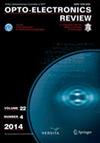基于微环谐振器和深度学习的介质化学浓度预测
IF 0.9
4区 工程技术
Q3 ENGINEERING, ELECTRICAL & ELECTRONIC
引用次数: 0
摘要
提出了一种利用微环谐振器(MRR)确定多元素介质浓度组成的新方法,该方法可以去除噪声并具有较高的平均精度。该方法使用两个神经网络,即卷积神经网络(CNN)和深度神经网络(DNN)。CNN将传输频谱与噪声区分开来。在输入DNN之前,该光谱用于获得选定的特征,DNN确定分析物中每种化学物质的浓度。这两个模型都训练与绝缘体上的硅环谐振器工作在λ=1.46 μm至λ=1.6μm的红外波长之间的水,乙醇,甲醇和丙醇的混合物,通过使用从有限差分特征模态获得的模拟数据,虽然同样的方法可以用于其他设计和化学组合。CNN使用高斯白噪声和泊松噪声叠加的MRR透射谱模拟各种噪声源进行训练,DNN则对提取的特征进行训练。0.0357-75%浓度范围的平均均方根误差为5.531%。本文章由计算机程序翻译,如有差异,请以英文原文为准。
Prediction of medium chemical concentration with micro-ring resonators and deep learning
A new approach for determining the concentration composition of a multi-element media using a micro-ring resonator (MRR) is proposed which allows for noise removal as well as moderately higher average accuracy. This method uses two neural networks, namely a convolutional neural network (CNN) and a deep neural network (DNN). The CNN differentiates the transmission spectrum from the noise. This spectrum is used to obtain selected features before being fed into the DNN, which determines the concentration of each chemical in the analyte. Both models are trained to work with a silicon on-insulator ring resonator operating between the infrared wavelengths of λ=1.46 μm to λ=1.6μm on mixtures of water, ethanol, methanol, and propanol by using simulation data obtained from finite difference eigenmode, although the same approach can be used with other designs and chemical combinations. The CNN was trained using the MRR transmission spectra superimposed with white Gaussian noise as well as Poisson noise to mimic various noise sources, while the DNN underwent training on the extracted features. Average Root-Mean-Square Error was for a range of concentrations from 0.0357-75% is 5.531%.
求助全文
通过发布文献求助,成功后即可免费获取论文全文。
去求助
来源期刊

Opto-Electronics Review
工程技术-工程:电子与电气
CiteScore
1.90
自引率
12.50%
发文量
0
审稿时长
>12 weeks
期刊介绍:
Opto-Electronics Review is peer-reviewed and quarterly published by the Polish Academy of Sciences (PAN) and the Association of Polish Electrical Engineers (SEP) in electronic version. It covers the whole field of theory, experimental techniques, and instrumentation and brings together, within one journal, contributions from a wide range of disciplines. The scope of the published papers includes any aspect of scientific, technological, technical and industrial works concerning generation, transmission, transformation, detection and application of light and other forms of radiative energy whose quantum unit is photon. Papers covering novel topics extending the frontiers in optoelectronics or photonics are very encouraged.
It has been established for the publication of high quality original papers from the following fields:
Optical Design and Applications,
Image Processing
Metamaterials,
Optoelectronic Materials,
Micro-Opto-Electro-Mechanical Systems,
Infrared Physics and Technology,
Modelling of Optoelectronic Devices, Semiconductor Lasers
Technology and Fabrication of Optoelectronic Devices,
Photonic Crystals,
Laser Physics, Technology and Applications,
Optical Sensors and Applications,
Photovoltaics,
Biomedical Optics and Photonics
 求助内容:
求助内容: 应助结果提醒方式:
应助结果提醒方式:


